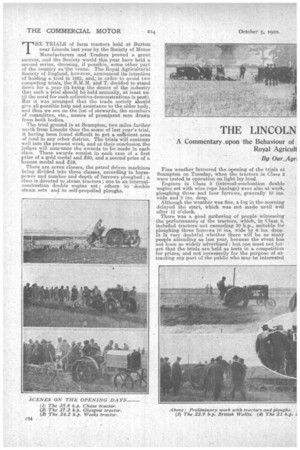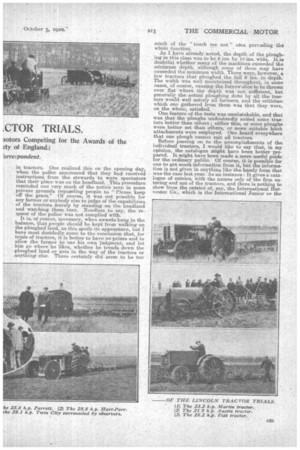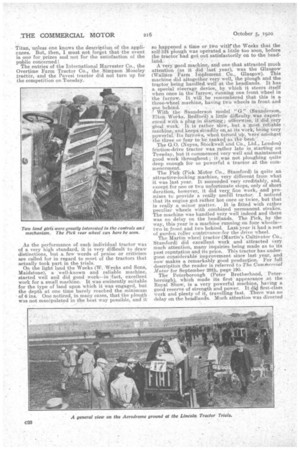THE LINCOLN
Page 24

Page 25

Page 26

Page 27

Page 28

If you've noticed an error in this article please click here to report it so we can fix it.
LCTOR TRIALS.
By Our Agri
#91-respondent. THE TRIALS of farm tractors held at Burton near Lincoln last year by the Society of Motor Manufacturers and Traders proved a great success, and the Society would this year have held a second series, choosing, if possible, some other part of the country as-the venue, The Royal Agricultural Society of England, however, announced its intention of holding a trial in 1921; and; in order to avoid two competing trials, the S.M.M. and T. decided to stand down for a year (it being the desire of the industry that such a trial should be held annually, at least until the need for such collective demonstrations is past). But it was arranged that the trade society should give all possible help and assistance to the older body, and thus we see bn the list of stewards, the members of committee, etc., names of prominent men drawn from both bodies.
• The trial ground is at Scampton, two miles further north from Lincoln than the scene af last year's trial, it having been found difficult to get a sufficient area of land in any other district. The trials will continue well into the present Week, and at their conclusion the judges will announce the awards to be made in each class. These awards consist in each case of a first prize of a gold medal and 220, and a second prize of a bronze medal and 210.
There are seven classes, the petrol driven machines being divided into three classes, according to horsepower and number and depth of furrows ploughed' a class is devoted to steam tractors; one to an internalcombustion double engine set ; others to double steam sets and to self7propelled ploughs.
Fine weather favoured the opening of the trials at Scamptan on Tuesday, when the tractors in. Class 2 were tested in operation on light ley land.
Engines in Class 5 (internal-combustion double engine set with wire rope haulage) were also at work, ploughing three and four furrows, generally 10 ins. wide and 8 ins. deep. Although the weather was fine, a fog in the morning delayed the start, which was not made until well after 11 o'clock.
There was a. goad gathering of people witnessing the performanoes of the tractors, which, in Class 2, included tractors not exceeding 30 h.p., suitable for ploughing three furrows 10 ins, wide by 6 ins. deep. It is very doubtful whether there will be as many people attending as last year because the event has not been so widely advertised; but. one must not forget that the trials are held as tests in a competition for prizes, and not necessarily for the purpose of attracting any part of the public who may he interested
in tractors. One realized this on the opening day, when the police announced that they had received instructions from the stewards to warn spectators that their place was on the head/and. This procedure reminded one very much of the notice seen in some private grounds requesting people to "Please keep off the grass." Of course, it was not possible for any farmer or anybody else to judge of the capabilities of the tractors merely by standing on the headland and. watching them turn. Needless to say, the request of the police was not complied with. It is, of course, necessary, when awards hang in the balance, that people should be kept from walking on the ploughed land, as this spoils its appearance, but I have most decidedly come to the conclusion that, for trials of tractors, it is better to have no prizes and to alfow the farmer to use his own judgMent, and let him go where he likes, whether he treads down the ploughed land -or gets in the way of the tractors or anything else. There certainly did seem to be toe
much of the " touch me not " idea pervading the whole function.
As I have already noted, the depth of the ploughing in this class was to be 6 ins. by 10 ins. wide. It is doubtful whether many of the machines exceeded the minimum depth, although some of them may have exceeded the minimum width. There were, however, a few tractors that ploughed the full 6 ins, in depth: The width was well maintained throughout, in some cases, of course, causing the furrow slice to be thrown over fiat where the depth was not sufficient, but generally the actual ploughing done by all the tractors would well satisfy all farmers, and the eritieiwin which one gathered from them was that they were, on the whole, satisfied.
One feature of the tests was unmistakable, and that was that the ploughs undoubtedly suited some tractors batter than others ; either this, or some ploughs were better set than others; or more suitable hitch attachments were employed. One heard everywhere that one plough cannot suit all tractors.
Before passing on to the accomplishments of the individual tractors, I would like to say that, in my opinion, the catalogue might have been better prepared. It might have been made a more useful guide for the ordinary public. Of course, it is possible for one to get much information from it, but the information is not given in anything like the handy form that was the case last year. As an instance : It gives a catalogue of entries with the names only of the firm entering and not of the tractors, and there is nothing to show from the entrieS of, say, the International Harvester Co., which is the International Junior or the
Titan, unless one knows the description of the appliances. But, then, I must not forget that the event is one for prizes and not for the satisfaction of the public concerned I The entries of the International Harvester Co., the Overtime Farm Tractor Co., the Simpson Moseley tractor, and the Pavesi tractor did not turn up for the competition on Tuesday.
As the performance of each individual tractor was of a very high standard, it is very difficult to draw distinctions, but a. few words of praise or criticism are called for in regard to most of the tractors that actually took part in the trials.
On the light land the Weeks (W. Weeks and Sons, Maidstone), a -well-known and reliable machine, started well and did good work—in fact, • excellent work for a. small machine. It was.erninentIy suitable for the type of land upon Which it was engaged, but the depth at one time barely reached the minimum of *3 ins. One noticed, in many cases, that the plough was not Manipulated in the best way possible, and it
so happened a time or two witirthe Weeks that the self-lift plough was ope'rated a little too soon, before the tractor'had got out satisfactorily on to -the headland. .
A'very g,00d machine, and one.lhat attracted much attention (as it did last year), was the Glasgow (Wallace }arm Tinplement Co., Glasgow). This machine did altogether very .well, the plough and the tractor being handled. well at the headlands. It has a special steerage device,.._ by which it steers itself when once in the furrow, running one front wheel in the " furrow. It will . be remembered that this is a, three-wheel machine, having twa Wheels in front, and
yne behind. .
With the Saunderson model "G," (Saunderson, Elton Works, Bedford) a little difficulty was experienced with a plug-in starting; otherwise, it didvery good work. It is rather Slow, but a most reliable machine, and keeps s'teadily, .oikat its work, being very pewerful. Its furrows, when turned up, 'were aniarigst the three or four to be,ranked-as -16 best i :.
The G.O. (Noyes Stockwell and CO. Ltd., London) friction-drive tractor was. rather late' in, starting. on Tuesday, but it commenced very well and maintained good work throughout ; it , was not ploughing quite deep enough for so powerful a tractor at the commencement.
The Pick (Pick Motor Co., Stamford) is quite an attractive-looking machine, very different from what it was last year. It succeeded very creditably, and, except for one or two unfortunate stops, only of short duration, however, it did very. fine work, and promises to provide' a really useful tractor. I noticed that its engine got rather. hot once or twice, but that is really a minor matter. It is fitted with rather peculiar wheels with .combined permanent. strakes. The machine was handled Veiy well indeed and there was no delay on the headlands. The Pick, by the way, this year is a machine running' on four wheels— two in front, and two behind. Last year it had a sort of garden roller contrivance■for the drive wheel.
The Martin wheel tractor (Martin's.Cultivator Co., Stamford) did excellent work and attracted very much attention, many inquiries being made as to its past reputation and its price. This tractor has undergone considerable' improvement since last year, and now makes a remarkably good production. For full description the reader is referred to -The. Comihercial .1lotor for September 28th, page 190. The Peterborough (Peter Brotherhood, .Peterboraugh), which Made its first' appearance at the Royal Show, is a, very powerful machine; having a good reserve of strength and power. It cIi4 first-class. work and plenty of it, travelling fast_ .There was no delay an the headlands. Much attention Was directed
to it, and its furrow was one of the best. The Peterborough really is a very promising machine.
The Fiat (Fiat Motors, Ltd., London). is a good machine throughout, and in the. trialsgave every . satisfaction to all concereed.
Among the American machines the E.B. did well, turning a very fine furrew ; the Case suffered from difficulty in getting the setting of the plough or getting the hitch right.; the Chase did excellent work at a satisfactory rate ; the Twin City worked . at a fairly fast rate tittid did good work; but its furrow was not so satisfactory.
There is no doubt that the credit for the straightest and best furrow falls, to the Cleveland (H. G.•Burfordand Co., London), which is ,a chain track agrimotor. The only fault with the furrow was that the grass was not quite sufficiently -covered.. The furrow was exceedingly straight, which augurs well for the steering device by means of two small guide wheels running in the furrow in front of the machine, and extending from the front of the machine. Of course, chain tick machines on this very favourable land were not: able to display their best possibilities under heavier and wetter soil conditions, hut the furrow really was a . good one and much appreciated by the farmers.
The Blackstone . caterpillar tractor (Blackstone's, Starriford).had ploughed out a very large area bys12.30 at a good derPth, "as deep as you would want it. for . potatoes." The plough might have been handled i better in setting n from the headlands.
The British Wallis was entered by the Ancona Motor CO. It turned out .a good furrow and maintained it reputation throughout. . It got over the ground very fast in fact too fast to enable it to turn
out the best work. . • .
The Austin (The. Austin Austin Motor Co., Northfield), which has now :become one of the best kn-own tractors in the country, was well equal to its task, and performed good work in reasonable. time The machine attracted a deal of attention, and the only fault one conld.find was in regard to the handling of the plough by the operator, who might have done this better.
' The Parrett (Agri-Tractor Contract Co.., Royston, Herts.) tractor wits ploughing in rather long grass and as this was not all covered, it gave the work rather 'an unfinished appearance. but its ploughing was deeper than that of any other tracthr. It was regularly 7 ins., and in some 'cases more than that. The machine runs on petrol and, Of course; the greater depth of ploughing will -make. a Considerable difference in regard to
filel conOrnption. . • . _ The Hart-Parr is a new machine as far as this . country is concerned, from America, entered by the Agricultural Wholesale Society. The depth of its
ploughing was a full 6 ins., and it appeared-to be very satisfactory, 'particularly in regard to the-'finiall of its _ work and its whole performance in this..resPect. • There is Still -much diversity of opinionin certain quarters AS to' .thp capacity of the -'Ordinary standard agrimotor being ableto deal with heavy -land. In some cases,farmers have made -up their minds that direct traction is not suitable as it Mechanical means for cultivating heavy land because the --compression Consolidates' and thereby injures the soil. In 'vie of this; the work ofClasses -5 and 6 has proved very interesting. Class 5' included the internal-combustion double engine .set with wire rope haulage, for ploughing three or four. furrows 10 ins. .wide by 8 ins, deep, the engine to comply with the Light Locomotive Acts. There were only two entries, namely, John Fowler and Co. (Leeds), Ltd., and J. and H. McLaren; Ltd., also of Leeds. The work of both sets was exceedingly good. The internal-combustion engine for this kind of work is quite a new thing, except for the Victoria oil ploughing engines made by Messrs. Walsh and Clerk, who were not competitors this year
The Fowler set I had not seen before my visit to Lincoln. It appeared to be a thoroughly well designed appliance, very powerful, and in outside appearance was like a huge direct traction agrimotor. Of course, its work was done by a specially designed one-way plough attached by a cable to each engine. The Fowler ploughed five furrows to the required depth and the McLaren four. The latter is a very well constructed machine, lighter than the Fowler, but designed in such a way as to be able to exert tremendous power in the performance of its work. It received the attention of a large number of visitors, and so did the .Fowler.
In Class 6 there was only one entry, that of Messrs. John Fewler and Co. (Leeds), Ltd., of their double steam engine set with wire rope haulage for ploughing not less than three furrows 10 ins, wide by 5 ins. deep, engine to comply with the Light Locomotives Acts. This was a very attractive set, the number of ploughs drawn being five, and the work was well dote. The tests were held in the same field as the tests for Classes 4 and 5, and provided a good opportunity for comparisons, between the -work of the internal-combustion cable set and the steam set.
In Class 4, for direct traction steam-engine plant, suitable for ploughing four furrows 10 ins, wide by 8 ins. deep, engine to comply with Light Locomotive Acts, there was only one entry, that of the Mann's Patent Steam Cart and Wagon Co., who had their steamer working by direct traction.. Its work was well done, and I should say that, for certain classes of land, it would be a suitable machine, but, as a general purpose engine for any land on any farm, I should be doubtful as to its, economic results.
In Class 1, for internal-combustion direct traction engines not exceeding 24 h.p., suitable for ploughing two farrows 10 ins, wide by 6 ins, deep, there were ten entries, but the International Junior and one of Saunderson's entries were withdrawn. Considerable excitement pervaded the proceedings of Class 3. Each machine was evidently vying with the other, both for speed and finished work throughout the whole of the tests. The plough used was the Ruston and Hornsby. It is a very good plough indeed, but caused considerable annoyance and delay to the tractors owing to the self-lift device not working as it should have done when setting in at the headlands. The trip did not work properly, but I understand that the. firm have -improvements in hand. It is to be hoped that it is so, otherwise a good plough will get a bad name.
The really new machine in this class was the Saunclerson Junior. This is a machine smaller than the ordinary and well-known Saunderson. It has a two-cylinder engine of 18-20 h.p. The new Saundeison_ is a good all-round engineering job. It worked very well, its only fault being that in regard to the radiator ; at any rate, the water reached boiling potnt after the machine had been at work for a time. This has been one of the minor troubles with the Saurulerson right through, that the water in the radiator is BO easily made to boil.
The entries that took part in the Class 7 tests included the Crawley, Fowler, Martin chain track, Moline, Boon (of Messrs. Ransomes, Sims and Jefferies), and the Santler. The Sarktler, which had a two-furrow plough on each end,, seemed a somewhat big machine only to carry two furrows. The only oneway plough entrant, the Timesaver, did not turn up. The further doings at the trials will be dealt with in o'ur next issue.




















































